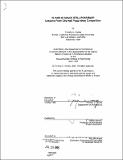| dc.contributor.advisor | Julian Beinart. | en_US |
| dc.contributor.author | Hurley, Timothy C. (Timothy Colyer) | en_US |
| dc.contributor.other | Massachusetts Institute of Technology. Dept. of Architecture. | en_US |
| dc.coverage.spatial | n-us-ma | en_US |
| dc.date.accessioned | 2011-12-05T19:53:29Z | |
| dc.date.available | 2011-12-05T19:53:29Z | |
| dc.date.copyright | 1995 | en_US |
| dc.date.issued | 1995 | en_US |
| dc.identifier.uri | http://hdl.handle.net/1721.1/67432 | |
| dc.description | Thesis (M.S.)--Massachusetts Institute of Technology, Dept. of Architecture, 1995. | en_US |
| dc.description | Includes bibliographical references (leaves 101-102). | en_US |
| dc.description.abstract | In Autumn, 1994, the City of Boston, in partnership with the Boston Society of Architects and the Building Owners and Managers Association, sponsored the Revitalizing City Hall Plaza Ideas Competition. The Competition sought ideas from design professionals and lay people for ways to popularize and invigorate City Hall Plaza. The program espoused by Mayor Menino was simple: "We must create an atmosphere that will more easily link the public to an open and accessible City Hall, and provide a meeting place for Boston's diverse community." This Competition represents two aspects of thought regarding public space; one specific and one general. Specifically, the effort to revitalize City Hall Plaza is consistent with long-standing desires to create or retain a high level of activity and stability in the Government Center vicinity. In focusing attention on the condition of the existing Plaza, this Competition continues a tradition of seeking a strong anchor for downtown Boston, maintaining an urban vitality and richness, and creating an image bespeaking Boston's regional and national prominence. Generally, the Competition created avenues for discussions of the nature and role of public space. From 190 Competition entries it is possible to determine categories that reflect two different approaches to the design and consideration of public space. One is the Morphological approach, in which considerations of the physical form of the space and the urban fabric are primary. The other is the Programmatic approach, which stresses activities and programmed attractions independently of physical form. Using these entries and categories as data, a comparison of the categories is made which suggests that the Morphological approach is more appropriate for effecting long-term legibility and structure to a city. However, the salient characteristics of the Programmatic cannot be overlooked, especially in a modern economy. Therefore, it is ultimately concluded that the vitality of a city is best served when the immediacy of the Programmatic is appropriately housed in the permanence of the Morphological. To achieve this is to retain a vision of purposes for cities and their spaces beyond mere functionality, which speaks to the aspirations for community and humanness that have historically informed the creation of public space. | en_US |
| dc.description.statementofresponsibility | by Timothy C. Hurley. | en_US |
| dc.format.extent | 102 leaves | en_US |
| dc.language.iso | eng | en_US |
| dc.publisher | Massachusetts Institute of Technology | en_US |
| dc.rights | M.I.T. theses are protected by
copyright. They may be viewed from this source for any purpose, but
reproduction or distribution in any format is prohibited without written
permission. See provided URL for inquiries about permission. | en_US |
| dc.rights.uri | http://dspace.mit.edu/handle/1721.1/7582 | en_US |
| dc.subject | Architecture. | en_US |
| dc.title | Is public space still possible? : lessons from City Hall Plaza ideas competition | en_US |
| dc.type | Thesis | en_US |
| dc.description.degree | M.S. | en_US |
| dc.contributor.department | Massachusetts Institute of Technology. Department of Architecture | |
| dc.identifier.oclc | 33337769 | en_US |
